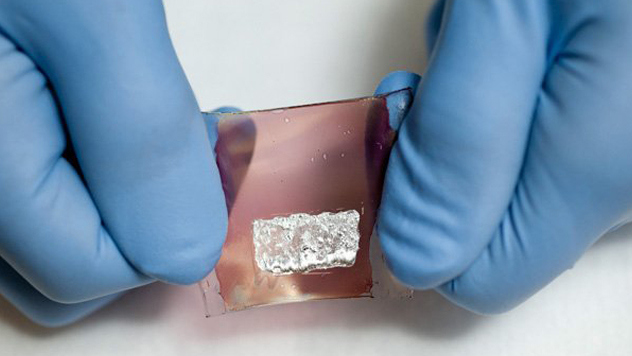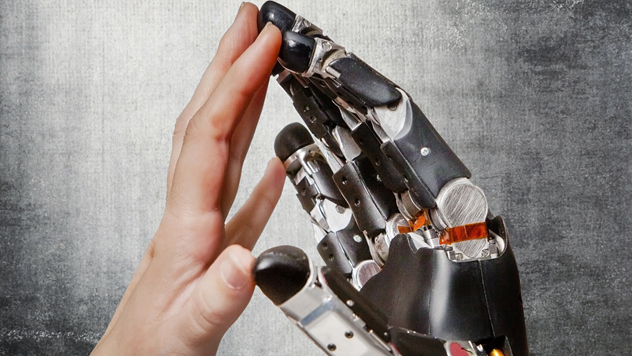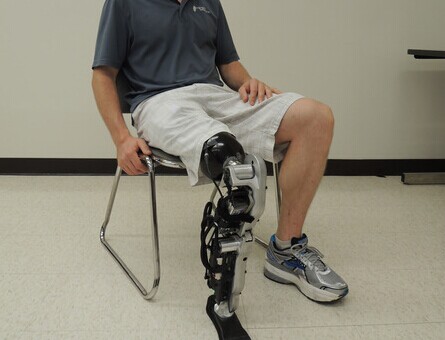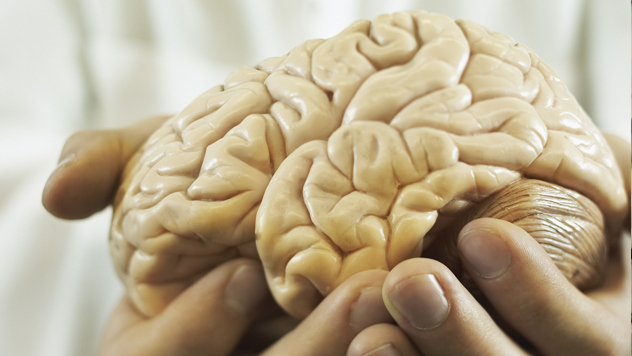(单词翻译:单击)
Human bodies are frail, easily damaged packages full of parts that can never fully come back once lost. Luckily, researchers worldwide are working on replacing every bit of the body to make us all cyborgs.
人的身体是十分脆弱的,有些娇弱的器官一旦破坏就永远难以复原。幸运的是,世界各地的研究人员都在研究能替代我们身体部位的生化机械器官。
10.Supersensitive Electronic Skin
10.超敏感电子皮肤

Skin has the thankless job of coating and protecting your whole body, making it your most easily damaged organ. When you burn or rip off a stretch of skin, your main option right now is to graft some back on from elsewhere on your body. But an effective synthetic replacement skin may not be that far off, thanks to research from Stanford scientists. Stanford's Zhenan Baohas has developed a super-flexible, super-durable, and super-sensitive material that can be the basis for future synthetic skin. People have tried developing synthetic skin before, but Baohas's material handles touch sensitivity better than any predecessor. It contains organic transistors and a layer of elastic, letting it stretch without taking damage. And it's self-powered—this skin contains a series of elastic solar cells.
皮肤辛苦的担任着包裹我们和保护我们整个身体的责任,因此它也成为了最容易被伤害的器官。当皮肤被烧伤或者被割破,你最快的选择是从身体其他部位移植一部分过来。然而,感谢斯坦福大学科学家的研究,一种能有效替代人体皮肤的材料,不久后将面世。坦福大学的Zhenan Baohas 研发出了一种具备超弹性、超耐性和超敏感的材料,能够作为未来发展人工皮肤的基础。以前,人们也研究过生化皮肤,但是Baohas的材料比以前研发出来的更具敏感性。它带有有机转换物质和一层弹性材料,保证它在不被破坏情况下的延展性。另外,这种材料带有一系列的太阳能电池元件,可以自动充电。
9.Beating Hearts Created In A Petri Dish
9.在培养皿中跳动的心脏

Scientists have long investigated stem cells' potential for growing hearts, and they reached a major milestone this year when they created heart tissue than can beat on its own.The University of Pittsburgh team used stem cells made from skin to make MCPs, a special kind of cell that acts as a precursor to cardiovascular tissue. They then placed these cells on a 3-D scaffold designed to support a mouse heart. Within 20 days, the new heart began beating at 40 to 50 beats per minute.This heart is too weak to actually pump blood, which is the primary reason anyone would want an new heart. But the tissue has a lot of potential for patching heart muscles that have suffered damage.
长久以来,科学家一直在研究干细胞分化为心脏组织的潜力,今年当他们创造出可以自己搏动的心脏组织时,这一研究工作达到了一个重要的里程碑。匹兹堡大学的研究小组从来自皮肤的干细胞培养出MCPs,一种可以作为心血管组织驱动器的特殊细胞。他们把这些细胞放在一种可以维持老鼠心脏的3-D支架上。在20天内,新的心脏开始以每分钟40~50次的速率搏动。虽然这个心脏太虚弱,不能真的输送血液,但是这种细胞组织在修复受伤的心脏肌肉方面具有巨大潜力。
8.Prosthetic Hands That Sense Touch
8.触感人造手

Current prosthetic hands do little beyond filling the arm-shaped space between your body and the air. Sure, they can grasp things all right, and they help in balance, but they lack one of the human hand's most important abilities—the sense of touch. People with prosthetics can't detect if they're in contact with an object without looking at it directly. A research team at the University of Chicago has solved this problem, producing hands that send electric signals to the brain. They've begun with monkeys as test subjects, studying the animals to see how their brains respond to touch. When outfitted with prosthetic hands that stimulate their brains that way, the monkeys respond just as though they physically touch objects themselves. Programming these same signals into artificial human limbs would give amputees replacement hands unlike anything we've developed before.
现在的假手除了具备手的外形外,几乎没有其他功能。当然,这些假手能够拿东西和保持身体平衡,但是它们缺乏人手最重要的功能之一——触感。装了假手的人在碰触到一样物品时,如果不用眼睛看,是没法判断东西的。芝加哥大学的一个研究小组制造了一种能够向大脑传递信号的假手来解决这个问题。他们以猴子为测试对象,研究动物大脑对触摸信号的反应。当装备了可以刺激大脑的假手后,那些猴子的反应就好像他们身体接触到了物体一样。将这些类似的信号通过编程的方式写入造假肢,会给截肢者带来和以前研发出来的产品完全不同的假肢。
7.Thought-Controlled Bionic Legs
7.思想控制仿生腿

Though bionic legs are of course a huge boon to amputees, they lack actual nerve connections with the body. As a result, walking on them is cumbersome and tiring. But last year, Seattle resident Zac Vawter was outfitted with the world's first thought-controlled leg, a bionic limb that takes signals directly from his mind.This technology previously existed for arms, but legs are rather more complicated. And since a misread signal can send you jumping off a bridge or in front of a moving car, thought-controlled legs need more stringent programming than equivalent arms. As one of the researchers delicately put it, “If you're using a bionic arm and it misbehaves, the elbow may move slightly. If the prosthetic leg misbehaves . . . that could be quite a safety issue.”Vawter climbed 103 floors of a Chicago skyscraper on his bionic leg, but its designers are still working on improving it. To optimize it for everyday use, they have to make it even thinner and lighter. Its successor (the iLeg Air?) may meet the Army's stated goal for a bionic leg—10,000 steps without recharging.
虽然仿生腿对截肢者来说是巨大的福音,但是它们与人体缺乏真正的神经联系,导致依靠仿生腿走路十分麻烦和劳累。但是去年,西雅图的居民Zac Vawter 安装了世界上第一支思想控制的腿,一种直接接受从他大脑发出信号的仿生肢体。这项技术曾经运用于武器,但是运用在仿生腿上会更复杂。误读信号可能导致安装者跳下桥或站在开动的车辆前,依靠思想控制的仿生腿需要比武器更为复杂的程序。正如研究者指出的那样:如果你使用仿生胳膊,而胳膊动作做错了,可能只是手肘偏移预订位置。而如果仿生腿动作做错了,那可能就是生命安全问题了。Vawter使用仿生腿在芝加哥一栋高楼里向上爬了103个阶梯,但是仿生腿的设计者们仍然在尝试提高它的性能。为了使它能适用于日常生活,设计者们必须让它更轻更薄。它的衍生品(充气仿生腿)可以满足陆军对于仿生腿的阶段性目标——行走一万步不用充电。
6.Miniature Human Brains
6.微型人脑

Brain death is a bit of an inconvenience if you're a fan of living, and if you're looking to replace yours with a spare, you're out of luck. Sure, maybe we'll one day be able to plant brains into skulls, but the brain's not just another organ. It contains all your thoughts and memories. They can plop a new brain in your head, but you'll still be gone, so the idea of making artificial brains may seem absurd.But that hasn't stopped scientists from growing actual human brains in a lab. Starting with nothing but stem cells, scientists in Austria this year managed to create brains equivalent to those in nine-week-old fetuses. These miniature brains are the size of peas and are incapable of thought—so far. The one thing keeping the brains from growing beyond this stage and becoming fully functional is that they have no blood supply.Though these brains aren't going into anyone's bodies, they're proving a great resource for scientists investigating brain diseases.
如果你热爱生存,那么脑死亡是一件不美好的事。而且,如果你想用空闲的大脑来替换,那你是绝对找不到的。当然,也许有一天,我们能将大脑放入头骨中,但是大脑跟别的器官不同。它装有你所有的思想和记忆。人们能在你头里放一个新的大脑,但是你还是不存在,所以人造大脑这种想法看起来很荒谬。但是这并没有阻止科学家在实验室发展人造大脑。今年奥地利的科学家仅从干细胞开始,成功地创造出等同于9个周大的婴儿的大脑。目前,这些大脑只有豌豆大小,也不能思考。阻止这些试验品发育成具有完全功能的大脑的因素是它们没有血液供给。尽管这些大脑没有进入任何人的身体,但是他们给科学院研究脑科疾病提供了原材料。
翻译:郑静 来源:前十网


